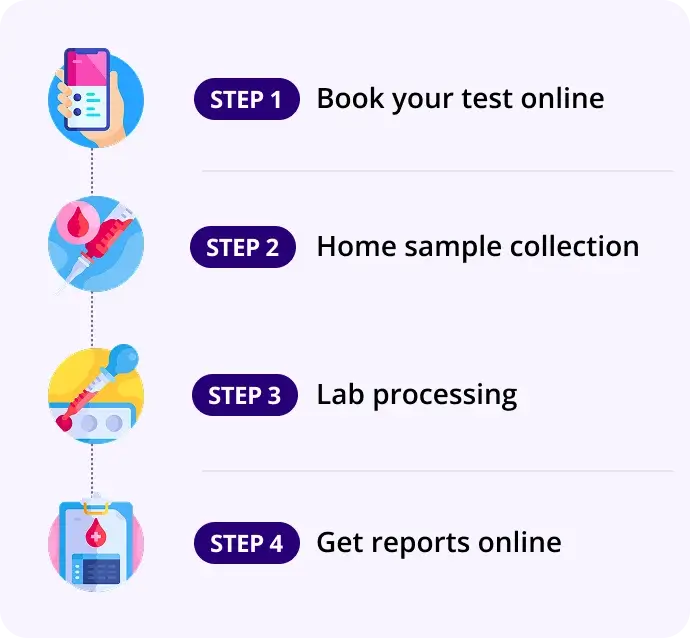Free PSA
Report in 16Hrs
At Home
No Fasting Required
Details
This ratio helps distinguish between benign prostate conditions like Benign Prostatic Hyperplasia (BPH) and prostate cancer, especially when total PSA is in the intermediate range (4–10 ng/mL)
₹449₹935
52% OFF
🧪 What is Free PSA?
Free PSA refers to the unbound form of Prostate-Specific Antigen (PSA) circulating freely in the blood. PSA is a protein produced by the prostate gland, and exists in two main forms in the bloodstream:
- Free PSA – Not bound to blood proteins
- Bound PSA – Attached to proteins like alpha-1-antichymotrypsin
The total PSA test measures both, while the free PSA test specifically measures the unbound fraction.
The % free PSA (free PSA / total PSA × 100) helps differentiate between benign prostate conditions and prostate cancer, especially when total PSA is moderately elevated (4–10 ng/mL).
❓ Why is the Free PSA Test Done?
To:
- Refine prostate cancer risk when total PSA is borderline (4–10 ng/mL)
- Differentiate between:
- Benign Prostatic Hyperplasia (BPH)
- Prostatitis
- Prostate cancer
- Decide whether prostate biopsy is necessary
- Monitor patients with elevated PSA levels
📊 Normal Ranges
Parameter | Normal Range |
|---|---|
Free PSA | Lab-dependent; reported as a value or % of total PSA |
% Free PSA (Free PSA / Total PSA × 100) |
- >25% → Low risk of prostate cancer
- 10–25% → Intermediate risk
- <10% → High risk of prostate cancer
🔍 Percent free PSA is most clinically meaningful when total PSA is between 4 and 10 ng/mL.
📈 Interpretation of Free PSA Results
% Free PSA | Risk Interpretation |
|---|---|
>25% | Suggests benign cause (e.g., BPH) |
10–25% | Gray zone – biopsy decision based on age, family history, DRE, etc. |
<10% | Suggests higher risk of prostate cancer |
PSA levels can be influenced by age, prostate size, infection, recent ejaculation, and procedures like DRE or catheterization.
🧠 Associated Organs and Conditions
Organ | Relevance |
|---|---|
Prostate Gland | Primary source of PSA production |
Urinary Tract | Inflammation or instrumentation can elevate PSA |
Liver/Kidneys | Clear PSA from circulation (less clinically relevant) |
❌ Causes of Elevated Total PSA with Normal Free PSA Ratio
- Benign Prostatic Hyperplasia (BPH)
- Prostatitis
- Urinary tract infection
- Recent ejaculation
- Prostate manipulation (e.g., DRE, catheter)
🔄 Related / Follow-Up Tests
- Total PSA
- Digital Rectal Exam (DRE)
- PSA Density (PSA/prostate volume)
- PSA Velocity (change over time)
- Prostate MRI
- Prostate Biopsy – If high suspicion
- PCA3 / PHI (Prostate Health Index) – Additional prostate cancer markers
✅ Fasting Required?
Parameter | Requirement |
|---|---|
Fasting Required? | ❌ No fasting required for Free PSA testing |
⚠️ Avoid ejaculation or prostate manipulation (e.g., DRE, cycling) for 24–48 hours before the test to avoid falsely elevated PSA levels.
📝 Summary
Parameter | Summary |
|---|---|
What | Measures unbound PSA in the blood to assess prostate cancer risk |
Why Test | To differentiate between BPH and prostate cancer, especially when total PSA is 4–10 ng/mL |
Normal % Free PSA | >25% suggests benign cause; <10% suggests higher cancer risk |
High Free PSA | Suggests BPH or prostatitis |
Low Free PSA (<10%) | Suggests higher likelihood of prostate cancer |
Follow-up Tests | Total PSA, DRE, MRI, biopsy, PSA velocity, PHI |
Fasting Required | ❌ No, but avoid ejaculation or DRE 24–48 hours prior |
How our test process works!

